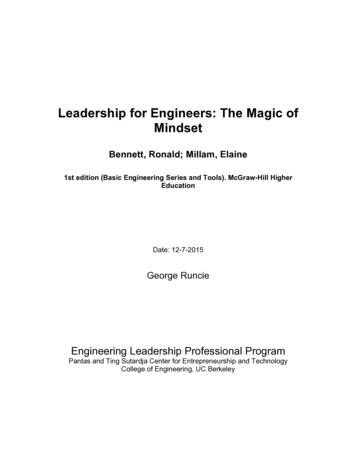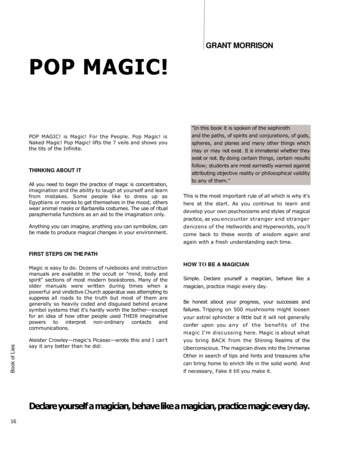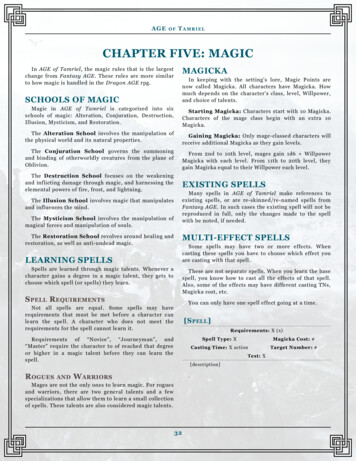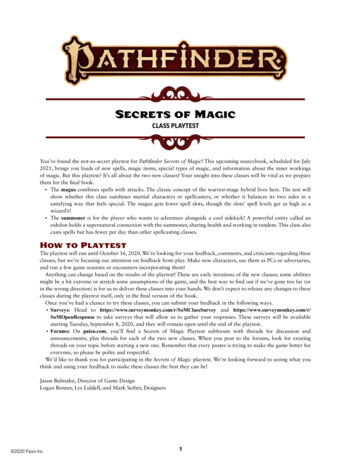
Transcription
Leadership for Engineers: The Magic ofMindsetBennett, Ronald; Millam, Elaine1st edition (Basic Engineering Series and Tools). McGraw-Hill HigherEducationDate: 12-7-2015George RuncieEngineering Leadership Professional ProgramPantas and Ting Sutardja Center for Entrepreneurship and TechnologyCollege of Engineering, UC Berkeley
Table&of&Contents&LEADERSHIP FOR ENGINEERS: THE MAGIC OF MINDSET!1!BENNETT, RONALD; MILLAM, ELAINE!1!1ST EDITION (BASIC ENGINEERING SERIES AND TOOLS). MCGRAW-HILLHIGHER EDUCATION!1!INTRODUCTION!3!SUMMARY!3!PART ONE: MYTHS!PART TWO: FINDING YOUR INNER LEADER!STAGE 1!STAGE 2!STAGE 3!STAGE 4!PART THREE: MAKING A DIFFERENCE!MY IDEAL SELF AND MY REAL SELF!MY LEARNING AGENDA!DEVELOPING TRUSTING RELATIONSHIPS!EXPERIMENTING!PART FOUR: WHY THE WORLD NEEDS N!8!!!!!!!!!!!!!
IntroductionIn the latest installment of the movie franchise “James Bond”, “Spectre”, Jameswas asked why he was in that line of work. His answer was that he neverstopped to think about it. In the book, “Leadership for Engineers: The Magic ofMindset” by Ronald Bennett and Elaine Millam, the authors cover topics aboutself-examination and self-awareness with the aim to engage the reader as to whythey are leaders and why they would like to continue to be leaders in their field ofwork. The book comprises four parts and sixteen chapters. It covers thefollowing material: Myths about engineers as leaders Assessing engineering leadership potential Becoming better leaders using reflection and social techniques Identifying the engineer leader’s mission.SummaryPart One: Myths“Leadership for Engineers: The Magic of Mindset” starts by dismissing somepopular myths about leaders and the roles they play. The idea behind listing themyths is for the reader to examine his beliefs and conclude which myths are realand which ones can be considered gossip. The book covers twenty mythsthroughout four chapters. Some of the most interesting myths were: Myth 9: Only Extroverts Can Be Good Leaders. Introverted characteristicsactually help people become effective leaders, as they prefer to listen andthink before taking action.Myth 10: Leadership Means Position Authority. Leadership is all aboutcollaboration and teamwork. “Management and leadership arecomplementary skills—but not all managers are leaders” (Page 17).Myth 18: Leaders Get MBA’s, Not Technical Degrees. True in the past,but becoming irrelevant as more educational institutions offer leadershipcourses to technical people like ELPP.Myth 20: People Want to Keep Their Expertise Secret. In order to succeedin today’s marketplace, engineering leaders understand that sharinginformation across teams is a necessary, if not required, practice toremain competitive.Part Two: Finding Your Inner LeaderThe authors outline the leadership development process as the path to find theleader’s inner truth. This process is formed by four ‘learning curve’ stages(George Leonard (1992) “Mastery”).Stage 1Few engineer leaders have gone through the process of assessing their skills,personalities and potential:
“We found the same thing with many emerging leaders. They confessed that theyhad never thought about themselves. They realized that most of their choiceshad been dictated by guidance from many others around them. They had nottaken the time to look carefully at who they truly were. They hadn’t assessedtheir values, their passions, their beliefs, or their strengths in any systematic way.Rather, they had followed a path that seemed comfortable, aligned with theirinterests, and pleased their close associates and family. They had taken theircues from others or had tried to emulate others. It was rare to hear that someonehad truly spent time to be intentional and deliberate in their choice making” (Page42).Stage 2Engineer leaders build self-awareness using assessment tools, which help themdiscover their learning styles, potential, personality, etc. These findings allowengineers to plan and develop leadership goals.The authors indicate five assessment tools to help expand one’s assessment:1. Using 360 feedback: Information from responses to open-endedquestions about the person being assessed. These questions are askedto the person’s colleagues.2. Measuring your emotional intelligence. “A multidimensional construct thatlinks emotion and cognition with the aim of improving human interactions(Mayer, Brackett, and Salovey 1997)” (Page 54):a. Awareness of one’s own and others’ emotionsb. Emotional facilitationc. Emotional understandingd. Management of one’s own and others’ emotionsBased on studies listed by the authors, these skills have proven to be anecessity for effective leaders.3. Learning about your preferences based on personality types. Based onthe Myers-Briggs Type Indicator (MBTI) personality inventory:a. Extraversion or Introversionb. Intuition or Sensingc. Feeling or Thinkingd. Judging or Perceiving4. Finding and classifying your learning style. Effective learning can beachieved by knowing one’s learning trends. According to studies (Kolb1981, 2007), learning is a cycle that encompasses four stages (see pic6.2):
a. Diverging (concrete, reflective): ability to learn through observation.Example: brainstormingb. Assimilating (abstract, reflective): learning by grouping differentobservations, such as designing tests to validate theories.c. Converging (abstract, active): practical application of ideas; solvingtechnical problems.d. Accommodating (concrete, active): learning by trial and error.Picture 6.2 (Page 65)5. Identifying your values and passions. Understanding one’s beliefs andvalues can directly influence a leader’s perspective to opportunities andpotential. A leader who’s aware of his values and beliefs can decide whichone to invalidate as to achieve different perspectives that are aligned withhis vision.Stage 3Using their new self-awareness, engineer leaders can reflect on their emotionalintelligence, learning styles and personalities to become conscious leaders.Furthermore, leaders in this stage have learned the value of personal growth, theimportance of their roles, and the relationships their roles create.Stage 4Engineer leaders have new vision of leadership based on their belief of making adifference in the world. Leaders at this stage have learned how to manage andtest their skills while becoming effective leaders with greater power of influence.Part Three: Making a DifferenceChapters in part three elaborate on the aspects of stage four (above). Moreover,it describes a roadmap for leadership learning and growth. “Richard Boyatzis
and colleagues (2008) have developed an Intentional Change Model, whichhelps people engage in transformation and embrace it. The modelincludes several key elements” (see Figure 11.1) (Page 111):My Ideal Self and My Real SelfAfter identifying beliefs and passions through self-assessment, leaders becomeself-aware and can determine whom they are while formulating a vision of wherethey want to be in the world.My learning agendaEngineering leaders enhance personal strength and improve weaknesses tolearn, grow and achieve their vision. Some learning tactics mentioned by theauthors include ‘Action Learning’, which has the following form:Action - Reflection - Planning - ActionDeveloping trusting relationshipsLeaders must maintain close relationships with colleagues who can provideguidance and feedback on every step of the Intentional Change Model allowingfor continual growth.These relationships are nourished through active trust, which involvescommunicating at all levels: body language, empathy, tone of voice, timing, paceand intensity.ExperimentingLeaders try new leadership methods demonstrating their new strengths.
Part Four: Why The World Needs YouEngineering leaders, by definition, are best suited to solve the problems of atechnological world. With their technical background and people skills,engineering leaders can collaborate to serve the public good.In part four, the authors also encourage engineering leaders to adopt thefollowing characteristics: Ethical Behavior: practice integrity and fair dealing, tolerance and respect.Companies that behave ethically perform better financially. Serve the Public Good: improve the human condition. Stewards of Nature: use material and energy resources for humanity’sbenefit. International collaboration: build relationships that help counterparts inother countries understand issues abroad and facilitate technical support. Develop Others: by helping others, leaders help themselves and theorganizations to which they belong.Evaluation“Leadership for Engineering” takes a different viewpoint to leadership. To be aneffective leader in a technological world, one must have technical expertise andpeople skills. In part one, the authors dismiss the idea of engineers as poorcandidates for leadership roles. Moreover, they illustrate why engineers arebetter suited for leadership positions than any other professional group. Thebook also indicates that leadership and management don’t share the same rolesalthough a person could do both.The development stages and assessment tests in part two walk the readerthrough the process of becoming self-aware. The book failed to order thecontent and made the process, at first, hard to follow. For example, all stagesare discussed in one chapter while the details of the stages are described infollowing chapters.Explaining the first stage (lack of self-awareness) and post assessment stagescan be helpful to engineering leaders and encourage them to complete theassessments in stage two. One reason most leaders don’t take assessments isbecause the benefits of knowing the assessment results are not explained.Expanding the definition of stage four (becoming effective leaders) in part threegives the reader the opportunity to understand it in depth, as it is the mostdynamic stage. Unfortunately, the authors don’t tell the readers that part three isabout stage four. Nonetheless, part three has several important points, includingthe chapters about trust and relationships.I believe the last part of the book, although important to any engineer (and notnecessarily to an engineer in a leadership role), does not fit well with the maincontext of the book. Part two and three are about the learning cycle an
engineering leader goes through to improve his leadership skills. Part four ismainly about how to function as an engineering leader.Conclusion&One aspect I found interesting about reading this book (unlike other leadershipbooks) is that it focuses on the psychology of the engineering leader’stendencies. Starting with the psychology assessments and how to establish trustbased on body behavior, the book has powerful insights about human interaction.Overall, I would recommend this book to my colleagues and friends. I would alsorecommend this book to be read before taking the ELLP course; being aware ofone’s leadership strengths and weaknesses can improve how the coursematerial is absorbed.
Mindset" by Ronald Bennett and Elaine Millam, the authors cover topics about self-examination and self-awareness with the aim to engage the reader as to why they are leaders and why they would like to continue to be leaders in their field of work. The book comprises four parts and sixteen chapters. It covers the following material:











